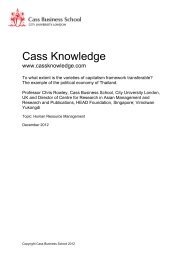A multi-stage model of governance in ... - Cass Knowledge
A multi-stage model of governance in ... - Cass Knowledge
A multi-stage model of governance in ... - Cass Knowledge
You also want an ePaper? Increase the reach of your titles
YUMPU automatically turns print PDFs into web optimized ePapers that Google loves.
<strong>Cass</strong> Centre for Pr<strong>of</strong>essional Service Firms – Work<strong>in</strong>g Paper 004 - 2010<br />
framework, these narratives support Gre<strong>in</strong>er’s core assertion that organizations pass<br />
through a series <strong>of</strong> identifiable <strong>stage</strong>s as they grow and mature. Given the similarity<br />
<strong>of</strong> the historical narratives presented <strong>in</strong> the thirteen case studies, it has been possible<br />
to develop a <strong>multi</strong>-<strong>stage</strong> <strong>model</strong> <strong>of</strong> <strong>governance</strong> which is specific to the context <strong>of</strong><br />
pr<strong>of</strong>essional service firms. In the follow<strong>in</strong>g section a conceptual overview <strong>of</strong> the<br />
<strong>model</strong> is presented. Given the limitations <strong>of</strong> space it is not possible to present<br />
detailed data for all the firms studied but <strong>in</strong> subsequent sections two detailed cases<br />
are presented which illustrate the complex and messy reality <strong>of</strong> ‘aborted excursions’<br />
<strong>in</strong> <strong>governance</strong> change <strong>in</strong> pr<strong>of</strong>essional service firms..<br />
Gre<strong>in</strong>er acknowledges the empirical limitations <strong>of</strong> his <strong>model</strong> <strong>in</strong> his revision to the<br />
1972 article but argues that it represents ‘a simple outl<strong>in</strong>e <strong>of</strong> the broad challenges<br />
fac<strong>in</strong>g management concerned with change’ (1998, p. 65). The <strong>model</strong> presented <strong>in</strong><br />
this current study shares some <strong>of</strong> the empirical limitations <strong>of</strong> Gre<strong>in</strong>er’s study but, by<br />
present<strong>in</strong>g ‘a simple outl<strong>in</strong>e’, the <strong>model</strong> provides a useful analytical device for<br />
explor<strong>in</strong>g the question: how does <strong>governance</strong> change over time as a<br />
pr<strong>of</strong>essional service firm <strong>in</strong>creases <strong>in</strong> size and complexity?<br />
A <strong>multi</strong>-<strong>stage</strong> <strong>model</strong> <strong>of</strong> <strong>governance</strong> <strong>in</strong> pr<strong>of</strong>essional service firms<br />
The <strong>model</strong> is presented <strong>in</strong> Figure I and described below. Illustrative quotes from five<br />
<strong>of</strong> the thirteen case studies are presented <strong>in</strong> Table 1. The PSF-specific <strong>model</strong><br />
focuses on the two key cont<strong>in</strong>gencies <strong>of</strong> age and size (as does Gre<strong>in</strong>er’s generic<br />
<strong>model</strong>). It identifies the various phases <strong>of</strong> <strong>governance</strong> that a pr<strong>of</strong>essional service firm<br />
may pass through as it grows and matures and highlights the potential ‘crises’ or<br />
transition po<strong>in</strong>ts. However, as Greenwood and H<strong>in</strong><strong>in</strong>gs (1988, p. 308) emphasize,<br />
13






